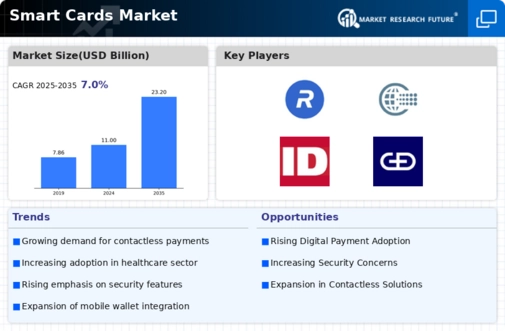Market Trends
Key Emerging Trends in the Smart Cards Market
The Smart Cards market is witnessing several noteworthy trends that are reshaping the industry landscape. One prominent trend is the increasing adoption of contactless and near-field communication (NFC) technology in smart cards. This trend has gained momentum, especially in the payment sector, as consumers seek faster and more convenient ways to complete transactions. The ability to make secure and swift payments with a simple tap of a card aligns with the growing demand for seamless and efficient payment solutions.
Biometric authentication integration is another significant trend in the Smart Cards market. As concerns over security and identity theft rise, biometric features such as fingerprint or facial recognition are being incorporated into smart cards to enhance authentication processes. This not only adds an extra layer of security but also addresses the need for user-friendly and reliable identity verification methods across various industries, including finance, healthcare, and access control systems.
The convergence of smart cards with Internet of Things (IoT) devices is an emerging trend that extends the capabilities of these cards. Smart cards are increasingly being used as secure tokens for IoT applications, enabling secure communication and data exchange between devices. This trend opens up new possibilities for applications in sectors like healthcare, where smart cards can be utilized to securely manage and share patient information across connected devices.
A growing trend in the Smart Cards market is the focus on eco-friendly and sustainable materials. With increased awareness of environmental issues, consumers and businesses are placing importance on smart cards that are produced using sustainable materials and manufacturing processes. This trend reflects a broader shift towards corporate social responsibility and environmentally conscious consumer choices.
The rise of digital identity solutions is influencing the Smart Cards market, with an increasing emphasis on secure and versatile identification methods. Smart cards are being used as a part of digital identity ecosystems, providing a secure and portable means for individuals to authenticate themselves in various digital interactions. This trend is particularly relevant in sectors such as government, healthcare, and online services where secure identity verification is paramount.
Blockchain technology is making its mark in the Smart Cards market, offering enhanced security and transparency. The integration of blockchain with smart cards provides a decentralized and tamper-proof way to store and authenticate information. This trend is gaining traction in applications like digital currencies, where secure and transparent transactions are crucial.
The Smart Cards market is witnessing a surge in the deployment of multi-application smart cards. These cards are designed to support multiple functions and applications within a single card, such as payment, access control, and transportation. This trend is driven by the need for streamlined solutions that offer versatility and convenience to users across different sectors.
The healthcare industry is increasingly leveraging smart cards for patient identification and electronic health record management. Smart cards in healthcare enable secure access to patient data, streamline administrative processes, and enhance overall healthcare delivery. This trend is expected to continue as the healthcare sector embraces digital transformation and emphasizes patient-centric care.
Integration with mobile devices is a growing trend in the Smart Cards market. Smart cards are being linked to mobile applications, allowing users to manage and control their cards through smartphones. This trend aligns with the broader shift towards mobile-centric lifestyles, offering users greater flexibility and control over their smart card functionalities.














Leave a Comment